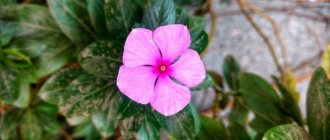Plant characteristics
The genus of this flower belongs to the Iris family. The deciduous form of the plant has a corm-like root system. Its stems are fleshy and elastic. They grow up to 1 meter, and at the top an inflorescence develops in the form of a spike. Growing in temperate climates requires a growth of up to 20 cm. The lanceolate shape of the leaf is slightly elongated, and it somewhat resembles a ribbon. The leaf is colored in a rich green shade.
By the end of May-June, bright flowers with a core of a contrasting shade (burgundy, yellow, purple) and bright petals begin to bloom. You can find sparaxis flowers in white, red, pink, burgundy, purple and other shades. In some varieties, in addition to the main shade, the petals have veins of a different color. Depending on the variety, the flower shape can be funnel-shaped or completely open.
On average, the diameter of a plant with six petals reaches 5 cm, and in the middle there is a pistil and 3 slightly twisted stamens.
Gallery: sparaxis (25 photos)
Known varieties
The genus of the flower is not varied. Scientists have identified only 6 varieties and up to 20 varieties. In Russia, only those varieties are grown that can develop in such a climate.
Sparaxis Tricolor (tricolor) is a plant with sword-shaped stems, the height of which reaches 50 cm. The inflorescence forms purple, red, white or yellow flowers with a bright core of a contrasting shade. Between the edges and the core you can see a ring of dark color (black or brown). This feature gave the flower its name. Based on tricolor sparaxis, scientists have developed several varieties:
- Bilbifera - tall inflorescence with yellow or snow-white flowers;
- Lord of Fire - blooms with scarlet petals and a black center;
- Low-growing mixture - plants on strong stems with yellow, red and white flowers;
- Grandiflora is a tall plant with bright inflorescences against a background of dark green foliage. Flowers can be purple, white, yellow, lilac. They are characterized by a strong aroma.
- Striped - bright orange petals contrast with the yellow center in an original way;
- Graceful - a plant up to 15 cm high, decorating the area with orange and yellow flowers.
Types and varieties of Sparaxis for open ground
General information about the exotic flower:
- perennial corm plant;
- Homeland: South Africa, Cape region. Sparaxis tricolor grows naturally in California;
- Iris family;
- number of species – 6;
- number of varieties – 20;
- flowering lasts throughout the summer;
- shades of petals: light and dark orange, scarlet, deep red, yellow, purple, white, pink, red-orange;
- in the central part of many species there is a contrasting center, then there is a dark border, after which the main color of the bud. Often different parts of the petal have two or three shades: contrasting or smoothly transitioning into each other;
- flower diameter – up to 6 cm;
- the buds look like a funnel or a star;
- the stem is thin, erect, in nature reaches 1 m, in cultivated varieties the length ranges from 15 to 60 cm;
- the leaves are bright green, reminiscent of a long sword;
- The plant does not tolerate low air temperatures and frosts.
- the rules for caring for exotics and the features of agrotechnical measures are similar to the cultivation of popular beautifully flowering species: Tritonia and Gladiolus;
- corms remain viable for up to three years;
- the Sparaxis plant loves illuminated areas;
- in warm regions, the bulbs successfully winter in the ground, provided that the base is carefully covered;
- good disease resistance;
- when dug up in September-October and during a dormant period during the autumn-winter period, bulbs tolerate storage worse than other plants of similar genera;
- highly decorative, actively used in landscape design;
- The plant is grown not only in open ground, but also in greenhouses. It is possible to force them for winter and spring holidays, like Hyacinths or Tulips, but the bulbs are more capricious and rot more often;
- the plant adds bright colors to the area and goes well with green lawns and many beautifully flowering species.
Popular varieties of Sparaxis:
- Bilbifera.
- Elegance.
- Superba.
- Elegant.
- Lord of Fire.
- Tricolor Mix.
- Grandiflora.
- Jumbo Star Mix.
- Striped.
In the garden, on the lawn, in the country house, in a hanging flowerpot, in a flower bed - the tropical species Sparaxis looks great everywhere. Photos of magnificent examples of garden decor are spectacular and delightful!
Growing from seeds
Since the plant is demanding, its cultivation should be approached responsibly. This requires preliminary cultivation of seedlings in boxes with fertile soil. Sparaxis prefers to grow in a humid and warm climate, and therefore the crops are kept in greenhouses or conditions close to them.
Seeds are placed in the ground to a depth of 10 mm and covered with film until germination. Young growth is thinned out, leaving a distance of 2 cm between plants. Seedlings are regularly watered and kept in a well-lit place. When the plant reaches 6–8 cm, the seedlings are transplanted into open ground. It is important that the threat of frost has passed.
Planting sparaxis in a permanent place involves maintaining a distance of 15 cm (growing for cutting) or 45 cm (for decorating the garden). The first year after sowing, you should not expect flowering, since the plant takes root and gains mass after planting.
2.Sparaxis planting and care
Do not remove drying leaves after flowering - they continue to feed the bulbs.
2.2.Reproduction, sparaxis from seeds
Propagation by seeds is quite easy, but the first time sparaxis will bloom only 2 years after planting. Daughter bulbs that often appear around the large mother bulb.
A well-drained mixture of coarse river sand, garden soil and leaf humus.
2.5.Containment temperature
Sparaxis loves warmth at home - after planting, asthenia is kept at a temperature of more than 20 ° C. After flowering and the death of the above-ground part, the bulbs are removed from the soil and stored in a cool and dry place.
2.7. Watering sparaxis
Abundant watering is necessary for sparaxis during the growing season. Allow the substrate to dry out between waterings. After the ground part dies, watering is reduced to a minimum.
2.9.Spraying
If the indoor air is too dry, place the pot with plants on a tray with damp pebbles or surround it with a layer of damp sphagnum. Spraying can be carried out in the morning, trying not to get droplets of moisture on the flowers and buds. Sparaxis prefers places with good air circulation.
2.10.Transfer
Every year, the bulbs are planted in fresh soil, in deep pots with large drainage holes. The planting depth is usually 3 times the height of the bulbs.
2.11.Diseases and pests of sparaxis
Bulbs rot if there is insufficient drainage. Mealybugs, aphids, spider mites, thrips. When grown in open ground, mole crickets may attack the flower.
Insects - pests
| Insect name | Signs of infection | Control measures |
| Mealybug or feltworm | The surface of the leaves and shoots is covered with a fluffy, cotton-like white coating. Plants lag behind in development | Folk remedies: spraying with soap and alcohol solution. Infusions of tobacco, garlic, cyclamen tubers, alcohol treatments, and pharmacy tincture of calendula have worked well. Chemicals: green soap solution, Actellik, Fitoverm. |
| Spider mite | Inconspicuous cobwebs on the leaves, yellowing and falling leaves with extensive damage. The surface of the leaf plates becomes dead and covered with small cracks. Plant development slows down. | Folk methods. Plants can be washed in the shower and left in the bathroom in a humid atmosphere for half an hour. Irradiation with an ultraviolet lamp every week for 2 minutes. Chemical preparations based on pyrethrum, sulfur powders, Fitoverm, Actellik. |
| Aphid | Sticky droplets appear on the leaf blades, the leaf blades curl and become deformed, tender buds and young leaves wither. Colonies of insects can be seen on the tips of shoots, buds or the underside of leaf blades. The flowers of plants affected by aphids may become deformed. | Folk methods: nettle infusion, decoction of rhubarb leaves, wormwood, soap solution, infusion of tobacco and dandelion, onion, marigold, yarrow, tansy, dusting with virgin ash. Chemicals: Sulfur powders, treatment of green mass with green potassium soap without getting into the ground, Decis, Actellik, Fitoverm. |
| Trips | The appearance of yellow spots on the leaf blades; small brown dots can be observed on the underside of the leaves. When pests spread, they cause leaves to turn yellow, dry out and fall off. | Folk methods. Increase air humidity, wipe the surface of the leaves with a soap solution to reduce the number of pests. Preparations based on pyrethrum - 2-fold treatment with an interval of 7 - 10 days, spraying with tobacco infusion, infusion of yarrow or Persian chamomile, decoction of cyclamen tubers. Chemical preparations: dusting with sulfur powders, using anabasine sulfate in a soap solution. |
| Medvedka | Withering and sudden death of a plant within a short period of time for no apparent reason. Holes in the ground about 2 cm in diameter. | Traditional methods: abundant watering with soap solution, kerosene, bird droppings solution. Chemicals: Medvetox, Thunder, Phenaxin plus, Grizzly, Zarit. |
- Mealybug
- Spider mite
- Aphid
- Trips
- Medvedka
2.12.Purpose
Sparaxis can be successfully used as a forcing plant. The first shoots appear 2 - 3 months after planting the bulbs.
Note.
Hydroponics.
Reproduction of sparaxis
The bulbous plant can be propagated at home by seeds and corms. True, the option with seeds is allowed only in warm climates or when planting in a greenhouse, since seedlings must be preserved without digging for 2 years until flowering.
Seeds are sown in ordinary pots or in seedling beds in August. They need to be germinated warmly in a nutritious, loose substrate. After the emergence of seedlings, thinning is carried out. After strengthening the young shoots, they are transferred to greenhouses or open ground.
Pests and diseases
With proper care, sparaxis is resistant to both pests and diseases, but if you allow chronic waterlogging of the soil, rot can affect the sparaxis corms, and this usually leads to its death.
If the leaves of the plant become dull and light, it is quite possible that the sparaxis lacks iron. Chlorosis can be eliminated by adding preparations containing this element in chelated form to the soil.
The main enemies of sparaxis are cold and lack of sunlight.
- “Capricious” heather: what to add to the soil when planting so that the acidity of the soil meets agrotechnical requirements?
On-site care
Originating from hot countries, sparaxis flowers require growing conditions as close as possible to tropical ones. Special care is also required:
- The flower is not afraid of hot rays, and with little shading it can lose the intensity of flowering. That is why the plant should be planted in a sunny area. Planting near trees, bushes and walls is not recommended.
- During the period of active development, the plant is very afraid of drought. That is why regular watering is an important condition for care. In dry spring, watering should be abundant and frequent. It is not difficult to understand that a flower needs watering - a small amount of foliage, the absence of buds and the yellow color of the leaves.
- Sparaxis likes high humidity. That is why, when caring for a flower, it should be sprayed several times a week. It is better to do this early in the morning to prevent leaf burns. Settled water is more suitable for such care.
- When growing sparaxis in flower beds, it is enough to apply fertilizer for bulbous plants once a month. No fertilizing is needed in the fall.
- Growing in containers requires slightly different care. Such flowers are watered more often and fed. Mineral fertilizers are added to the water twice or thrice a month (10 g per 5 liters).
Strategy for growing sparaxis in the middle zone
In severe winter conditions, in the middle zone and to the north, sparaxis can only be grown as a summer plant or as a bulbous plant with digging up for the winter. In many ways, the agricultural technology of this crop is similar to gladioli, because sparaxis will also have to be removed from the soil before the arrival of frost and stored indoors. But there is also a significant difference: sparaxis bulbs are much more capricious precisely at the stage of winter storage, they are more often damaged by rot, wither, and die. This is explained simply: the plant in nature must be in the soil in winter, and due to the shift in the timing of digging and completely different temperature conditions during the period of storage outside the soil, the bulbs suffer much more than gladioli, which are accustomed to such treatment.
This plant is more suitable for greenhouse cultivation than for open ground: this way it is much easier to satisfy all the vagaries of sparaxis and provide it with stable growing conditions
But even in open ground, if you can pay attention to the plant and take care of its needs, you can achieve success
Sparaxis tricolor. Arte Cifuentes
King of Landscaping
It is necessary to take into account that one bush does not look good in a flowerbed, and if it is planted among other flowers, it will get completely lost.
Sparaxis clearings made from varieties of different shades are considered the most effective. This is an unforgettable sight. In rock gardens, the flower looks gorgeous next to coniferous and succulent plants. When forming a stepped composition, it is better to place low-growing plants in the foreground. In small areas it is worth placing flowerpots with sparaxis near gazebos or verandas.
Your efforts will be appreciated!
Storage and wintering of bulbs
Corms are sensitive to any temperature changes and do not tolerate cold well, so they need special wintering conditions.
Before storage, planting material must be prepared:
- In the fall, dig up along with the above-ground part and carefully clear away the soil;
- Place in a dry and well-ventilated area to dry;
- When the above-ground part has completely withered and dried out, it must be separated from the bulb;
- The bulbs are stored in sawdust or straw at a stable temperature within +5-+9 degrees and in complete darkness.
During wintering, the bulbs should be periodically inspected, removing all rotten or dried specimens.
Before planting in open ground with the onset of spring, the box is transferred to a warm room (+25-+27 degrees) for awakening. This approach promotes rapid rooting and active growth.
Important: if babies have formed on the mother bulb, they are separated immediately before planting in open ground.
If optimal wintering conditions are created, sparaxis can be stored for 2-3 years without planting in a flower bed. It is important to avoid critical humidity levels - both excessive humidity and dry air are detrimental to the bulbs.











